Rails to the Rooftop of the World
Nobody believed it possible, except Beijing, which spent billions pounding train tracks where they had never before gone, miles high, to very Rooftop of the World. Tracks link long-isolated Tibet to China, but Tibetans fret that the railway will bring no benefit, strangling the serenity of Shangri-la.
By Ron Gluckman/ rolling from Chengdu across the Qinghai Plateu to Tibet
THE ASCENT WAS TREACHEROUS. My head was pounding even at the start of the approach to the soaring Himalayan peak. And I had plenty of company.
All around, people were dropping in the oxygen-starved air. In my arms, I cradled my companion on scores of Asian treks. In horror, I watched my pal stutter senselessly, flickering in and out of consciousness before uttering a final, fatal gasp.
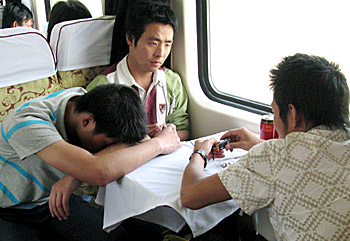 My Ipod was dead.
My Ipod was dead.
Much the same happened to other digital devices on first trains roaring through the clouds to Tibet.
No one really knew what to expect, since we were pioneers, riding rails where they had never stretched before.
Bags of crisps popped. Pens leaked. And there were plenty more pitfalls on maiden runs of the so-called Shangri-la Express as it traversed nearly three-mile high tracks to the very Rooftop of the World.
Cabins that were supposedly pressurized weren’t, so cleanup crews struggled to keep sinks clean as passengers succumbed to altitude sickness.
Carriages choked with smoke - even staff puffed away under "No Smoking" signs - and food and drink were in short supply.
The whole operation had an air of last-minute improvisation, which was not surprising given that the July 1 (2006) inaugural journey was months, even years ahead of previous estimates. Stations were closed or still under construction.
Then there was the advance misinformation, prompting huge ticket lines and price gouging. As so often is the case in China, political goals and self-congratulations came ahead of safety concerns and common sense.
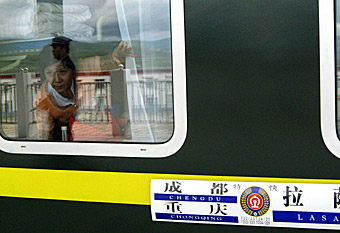 Still, whatever political hay was being pitched off track, on board, there was
no way to underscore the whoosh of excitement as we scattered enormous herds of
shaggy yaks grazing across the spectacular Qinghai Plateau, or the immense
thrill to top Tanggula Pass, at the ear-popping altitude of 5,028 meters, kind
of like scaling the tallest peak in Europe or the America’s Lower 48, only
doing it by train.
Still, whatever political hay was being pitched off track, on board, there was
no way to underscore the whoosh of excitement as we scattered enormous herds of
shaggy yaks grazing across the spectacular Qinghai Plateau, or the immense
thrill to top Tanggula Pass, at the ear-popping altitude of 5,028 meters, kind
of like scaling the tallest peak in Europe or the America’s Lower 48, only
doing it by train.
"This is historic achievement and a proud moment for the Chinese people," said He Yunsong, a teacher from the Number One Middle School in Hongjian, midway between Chengdu and Guangzhou.
"Nobody believed we could build this train."
That was the message pounded home by China’s press in the hysterical frenzy that lasted right up to the blast of the first whistle.
Television stations carried non-stop coverage of the first train pulling out of Beijing with dozens of journalists aboard. Chinese papers devoted entire sections to records set by a rail line that, at a whopping $4.2 billion, is among the world’s costliest.
Beijing didn’t boast of budget over-runs exceeding $1 billion.
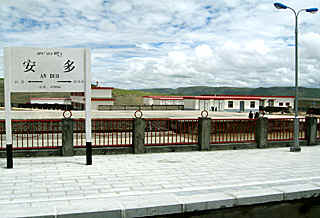 Instead, stories stressed care paid to environmental
concerns and creative engineering. Nor did the hoopla end after the first lucky
tourists clamored aboard.
Instead, stories stressed care paid to environmental
concerns and creative engineering. Nor did the hoopla end after the first lucky
tourists clamored aboard.
Hype continued in a special railway newspaper on the train, and on-board commemorative brochures that boasted of "the miracle in human’s railway construction history."
The sense of spectacle was highlighted as we debarked at stations - those that were open, in China - where TV crews filmed our arrival.
Of course, China never misses a chance to trumpet its achievements, but there was real reason to cheer this remarkable train.
In an era in which railroads have become dinosaurs from a distant age, China not only concocted a new railway, underpinned by truly innovative techniques, they sent it soaring into storybook territory straight out of the imagination.
Envisioned by communist leaders for half a century, the new track begins in Golmud, where earlier efforts to pound a railway to the world’s rooftop ended in the Cultural Revolution.
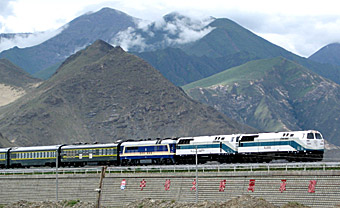 From there, road continues to Tibet on a backbreaking journey that has long been
legendary on endurance lists of arduous – or masochistic - travelers.
From there, road continues to Tibet on a backbreaking journey that has long been
legendary on endurance lists of arduous – or masochistic - travelers.
Engineers faced numerous daunting challenges in resuming the project in 2001. The new track covers 1,120 kilometers to Lhasa, mostly at altitudes higher than small planes usually fly.
Murray Hughes, editor of Railway Gazette International, termed it "the world’s most ambitious railway construction project."
Nearly 1,000 kilometers of rail runs at 4,000 meters or higher, and 550 kilometers of track tops permafrost. Chinese engineers devised ingenious processes to mitigate land shifts when the ground melts and re-freezes.
One method plants picket-fences of huge tubes that feed ammonia underground, keeping permafrost on ice.
Elsewhere, tracks are elevated over unstable ground, creating dream-like runs where we float over vast stretches of grassland, carpeted right to snow-sprinkled mountains on the horizon.
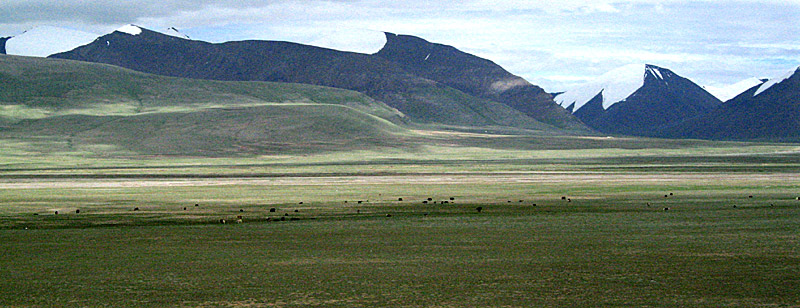
On the train, passengers crowd windows to marvel at the devices, like some wish list straight out of a laboratory. That it all works seemed to justify the miraculous tag.
The big question, though, is for how long? As this story went to press, reports of cracks in tracks and bridges appeared in Chinese media. (That same month, in August 2006, the first fatality was recorded when an elderly Hong Kong man succumbed to altitude sickness after riding the train to Tibet).
At the outset, Beijing was making a massive wager on untried technology in a most taxing environment. But few have grasped the exact extent of that bet.
Engineers had to predict climate change, in a region rarely traversed, less studied. They allowed a two-degree Celsius change over a century, a scale of global warming challenged even in China.
With railway, there is miniscule margin for error, more so in an environment where wind rages at 50 miles per hour and temperatures plunge to –30. If that wasn’t danger enough, the area is earthquake prone, shaken by a 8.1 tremor in 2001.
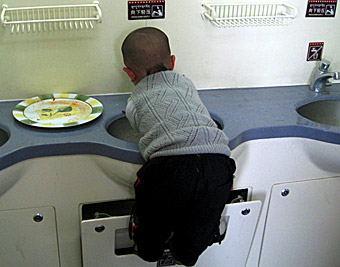 Yet the train ran smoothly on the first runs in July, with noticeably
less ratting than on older Chinese tracks.
Yet the train ran smoothly on the first runs in July, with noticeably
less ratting than on older Chinese tracks.
Sadly, innovation along the ties didn’t translate into much inside trains.
Carriages were comfortable, but cramped, with few amenities other than bedside LCDs in top-class berths, spewing non-stop propaganda on the glory of train construction or the wonders of travel in China’s Himalayan region.
Food was dished from old-fashioned metal carts, until water, beer, even rice simply ran out.
More appetizing options like observation decks and elegant dining rooms are promised in the future by several hospitality firms and one venture-capital outfit with ample publicity but no railway experience. Likewise widely-touted plans to seed the mountains with luxury resorts and spas to accommodate $1,000-a-day train tours.
For now, the Tibet train features new engines from Canada specially-designed for the arduous altitude, oxygen outlets, but the same carriages commonly seen across China.
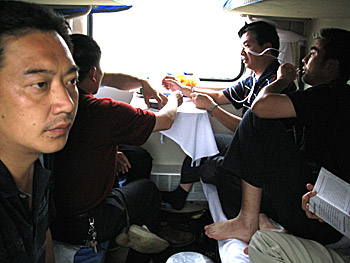 That means no showers, and only squat toilets for most passengers, especially in
hard-seat class.
That means no showers, and only squat toilets for most passengers, especially in
hard-seat class.
Actually, seats are padded, but it’s a sleepless two days on the longest route, almost 4,000 kilometers from Beijing.
Card games quickly sprouted as smoke and refuse filled the carriages, just like on any Chinese train.
The lack of on-board comfort is a minimal shortcoming compared with Tibetan views on the train. I happened to be in Tibet five years ago, when construction started, and was startled to find opinion, cautiously critical before, had only hardened.
This was a bit startling, since it is hard to imagine any part of the world, especially an area so isolated, that would oppose better transportation links.
But, as advocates right up to the Dalai Lama note, nobody consulted Tibetans about whether they even wanted a train.
"The railway line itself is not a cause of concern for the Tibetan people," a spokesman for the Dalai Lama told me. "How it will be used is the main concern."
Khedroob Thondup, nephew of the exiled Tibetan leader, was more explicit: "This is the second invasion of Tibet."
Beijing tried to blunt criticism with its usual propaganda, branding opponents terrorists.
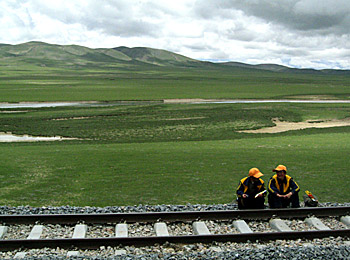 Pro-Beijing Tibetan officials were given podiums where they proclaimed this a
new "Road to Heaven." Tibetans, though, termed it a railway to hell.
Pro-Beijing Tibetan officials were given podiums where they proclaimed this a
new "Road to Heaven." Tibetans, though, termed it a railway to hell.
In Lhasa, and around Tibet, everyone expressed the same concern, that the train would only bring more Chinese workers to, as one guide said, "take our jobs and our houses, just like they already did our land."
Everybody told me the same, except Chinese, who, just as predicted, filled the train. I found only a handful of Tibetans on board.
And none working on the train, or at Lhasa’s massive new station, except for those polishing the marble floors or sweeping up outside.
"Enjoy your time in Lhasa now," said Nema, practically the first Tibetan I met, at Lhasa station, where we were queuing for hard-to-find tickets. "Next time you come," he added, "it might not be Lhasa anymore. The train changes everything."
Indeed, one glance at the station revealed Beijing’s designs for its restive rooftop area. The massive station is clearly equipped to handle far more than the three daily trains at launch.
Besides a daily Beijing train, initial service included trains on alternate days to Chongqing or Chengdu, and Xining or Naning. By the time you read this, service will be underway from Shanghai and Guangzhou, while operators are already promoting trains from other tourist destinations like Xian.
Whether this brings prosperity to Tibet will be debated for some time. What is certain is that that Tibet will be swamped with tourists, mainly Chinese.
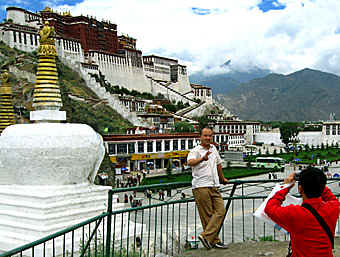 Already, flag-waving mainland groups have supplanted the odd foreigners in
safari gear. Tibet is so crowded that quotas were recently imposed on
crowds at Potala Palace, former home of the Dalai Lama.
Already, flag-waving mainland groups have supplanted the odd foreigners in
safari gear. Tibet is so crowded that quotas were recently imposed on
crowds at Potala Palace, former home of the Dalai Lama.
But all visitors have a chance to see the famous castle, on a billboard welcoming tourists to Tibet. Planted in front of the Potala is a huge Chinese flag.
That probably isn’t the view most train passengers will recall. Many complained about windows that didn’t open, smoke or squalid toilets, but all marveled at views seen only by rugged adventurers in the past: snow-capped peaks, the sprawling Qiangtang Grassland and birds roosting along the dazzling blue shores of Qinghai Lake.
As we descended from the Rooftop of the World, the mountains leveled and the views flattened. Passages cleared as few cared to gawk at the tile roofs and smokestacks.
Card games resumed, cigarettes were puffed with renewed relish. The oxygen was stowed away and our Ipods revived.
Too bad Tibet, like the fragile permafrost, won’t so easily recover.
Ron Gluckman is an American reporter an American reporter who has been roaming around Asia since 1991 for various publications, including the Far Eastern Economic Review (FEER). Among the first independent journalists on the Tibet train when it launched in July 2006, he filed many stories on the new railway and its impacts, including a story that FEER published in September 2006. Thi is the original version of that story.
All pictures by Ron Gluckman
To return to the opening page and index
push here
[right.htm]
